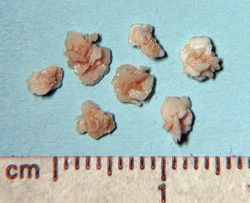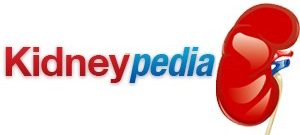
Calcium Oxalate Crystals
Kidney stones can be classified according to their chemical composition. Some 64 percent of kidney stones are calcium oxalate stones. 80 percent of kidney stones are based on some calcium compound or other, and 80 percent of calcium-
Calcium oxalate is a calcium compound that is found in nature, in certain plants, and in deposits left on containers as a result of brewing beer, where it’s known as “beer stones.” Beer stones have to be removed by cleaning or they can ruin the flavor of subsequent batches of beer by harboring
undesirable microorganisms. Rhubarb leaves have large amounts of calcium oxalate (and should be avoided by people suffering from kidney stones, as should other plants containing significant quantities of this mineral).
Aside from brewing and dietary considerations, the main reason calcium oxalate stones are of concern to human beings is that they are the most common type of kidney stone, which is an often painful and sometimes serious and dangerous affliction of the urinary system.
How Calcium Oxalate Stones Form
Kidney stones in general, and calcium oxalate stones in particular, form when dissolved minerals in urine precipitate and form solid crystalline objects. This can happen when the concentration of minerals in urine becomes too great, a condition called supersaturation. Sometimes that’s a result of drinking too little water, sometimes of excessive mineral intake, and sometimes of other factors. A diet very high in protein can generate kidney stones. So can certain problems in the kidney itself. There are many different underlying causes.
When the stone forms, the body attempts to pass it through the urinary tract and out of the body. For smaller stones, this is not difficult. However, when a kidney stone forms, it also begins to attract more molecules of the same mineral substance, so that the crystal begins to grow. When the crystal reaches a larger size (usually at least 5 millimeters in diameter), it becomes more difficult for the body to pass. The stone can become lodged in the kidneys or in various other parts of the urinary system, where it presents potentially severe health problems requiring treatment.
Symptoms Of Kidney Stones
The smallest stones can pass from the body without symptoms. The most common symptom of larger kidney stones is severe pain. Blockage of the urinary tract and difficulty urinating is also possible, and complications from this including nausea, vomiting, and other symptoms. Because acute pain is a common symptom even when the stone can be passed without surgical intervention, monitoring and pain management are key to treatment in most cases.
Treatment
Treatment for kidney stones varies from pain medication and monitoring to various kinds of surgical intervention ranging from the relatively non-
The most common type of surgical intervention is extracorporeal shock wave lithotripsy. This uses ultrasound pulses to shatter kidney stones into smaller fragments that the body can pass. It does not require any surgical incisions. The patient is placed on a bed and an ultrasound scan is used to determine the precise location of the kidney stone. Ultrasound bursts are fired into the body, and often this succeeds in breaking apart the kidney stone. Continued monitoring and pain management are necessary after treatment.
Other treatments include a type of lithotripsy that uses lasers instead of ultrasound pulses, surgery guided by a scope inserted into the urinary tract, and conventional surgery through an external incision. The preference of physicians is to use the least invasive form of treatment that is likely to be effective. In the majority of cases, no surgical intervention of any kind is called for.
Prevention
The best treatment for kidney stones is prevention, as with most diseases. The single most common risk factor for kidney stones is dehydration. Ensuring adequate hydration (basically a matter of drinking enough water) is important in prevention of kidney stones for that reason.
Dietary factors also contribute. Massive intake of vitamin C can increase the risk of kidney stones without improving nutrition (vitamin C is a water-
Besides dietary measures, the use of diuretic drugs has shown some success in prevention of stone recurrence for some types of kidney stone and under some conditions. Successful use also requires a low-
